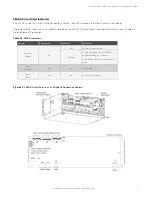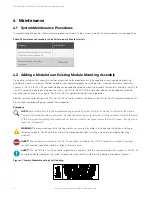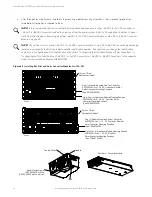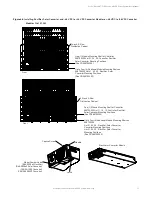
Vertiv™ NetSure™ 5100 Series -48 VDC Power System User Manual
Proprietary and Confidential © 2022 Vertiv Group Corp.
3
The controller has SNMP V3 capability for remote system management. The controller supports software upgrade via its USB port.
Refer to the NCU Controller Instructions (UM1M830BNA) for more information.
Module Mounting Assembly
The system contains one (1) to five (5) module mounting assemblies (depending on system configuration, see SAG582137100), which
may house rectifier modules, optional solar converter modules, optional -48 VDC to +24 VDC converter modules, optional -48 VDC to
-58 VDC converter modules, and a controller (depending on configuration, see PD588705300). Refer to PD588705300 for additional
information.
Rectifier Modules
The system contains rectifier modules, which provide load power, battery float current, and battery recharge current during normal
operating conditions. Refer to the Rectifier Instructions (UM1R482000E3) for more information.
Optional Solar Converter Modules
The system may contain solar converter modules (depending on configuration, see SAG582137100), which provide load power,
battery float current, and battery recharge current during solar conditions. Refer to the Solar Converter Instructions
(UM1S482000E3) for more information.
Optional -48 VDC to +24 VDC Converter Modules
Where +24 VDC load power is also required, converter modules are available (depending on configuration, see SAG582137100).
These converters operate from the main -48 VDC system bus to p24 VDC load power. Refer to the Converter Instructions
(UM1C48241500) for more information.
Optional -48 VDC to -58 VDC Converter Modules
Where -58 VDC load power is also required, converter modules are available. These converters operate from the main -48 VDC
system bus to provide -58 VDC load power. Refer to the Converter Instructions (UM1C48582000P3) for more information.
Optional Inverter Module Mounting Assembly
120 VAC @ up to 12kVA Inverter System
The system contains one or more inverter module mounting shelves and AC distribution.
The inverter system can be set to operate in one of the three input power modes, AC Input Power Mode, DC Input Power Mode, and
DC Only Input Power Mode.
•
In the AC Input Power Mode, each inverter module operates with the commercial AC input to supply 120 VAC power to the
loads. In the event commercial AC power fails or becomes abnormal, the inverter modules immediately transfer operation
with the 48 VDC input to power to the inverters.
•
In the DC Input Power Mode, each inverter module operates with the 48 VDC input to supply 120 VAC power to the loads. In
the event DC power fails or becomes abnormal or an inverter module fails, the inverter module immediately transfers
operation with the commercial 120 VAC input to power to the inverters.
•
In the DC Only Input Power Mode, each inverter module operates with the 48 VDC input to supply 120 VAC power to the
loads. In the event DC power fails or becomes abnormal or an inverter module fails, the inverter module shuts off.
This inverter system consists of the following components. Note that the inverter systems are pre-configured and do not have
expansion shelves. The ratings are not only determined by the maximum number of inverters the system can be provided with, but
also the rating of the AC distribution panel. The overall system rating cannot exceed the AC distribution panel rating.
•
Inverter Module Mounting Shelf(s)
The inverter system consists of one or more inverter module mounting shelves, depending on power rating. The inverter
module mounting shelves house the inverter modules.










































